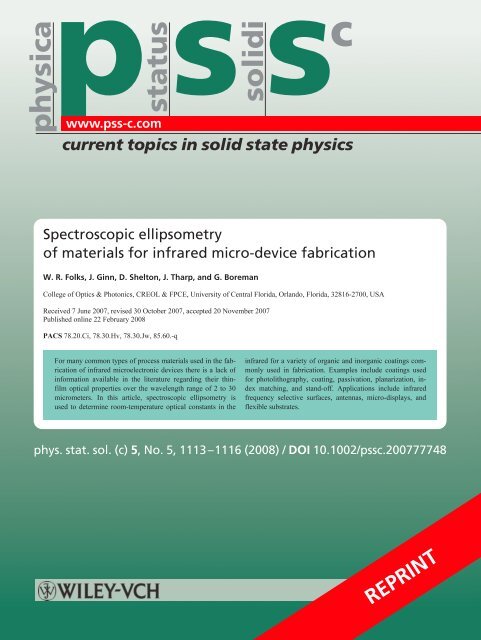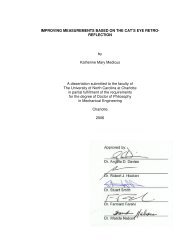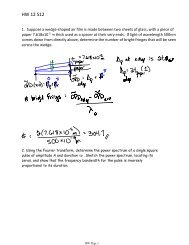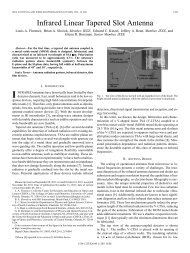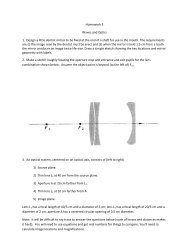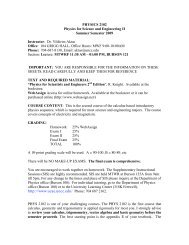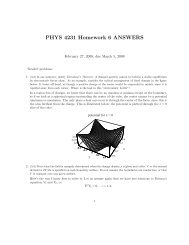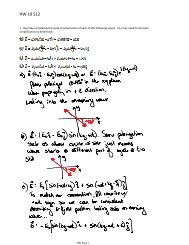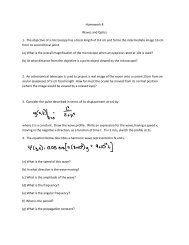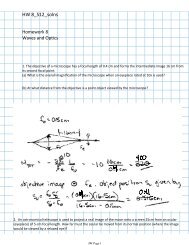Spectroscopic ellipsometry of materials for infrared micro ... - Physics
Spectroscopic ellipsometry of materials for infrared micro ... - Physics
Spectroscopic ellipsometry of materials for infrared micro ... - Physics
Create successful ePaper yourself
Turn your PDF publications into a flip-book with our unique Google optimized e-Paper software.
physica<br />
pss<br />
www.pss-c.com<br />
status<br />
solidi<br />
c<br />
current topics in solid state physics<br />
<strong>Spectroscopic</strong> <strong>ellipsometry</strong><br />
<strong>of</strong> <strong>materials</strong> <strong>for</strong> <strong>infrared</strong> <strong>micro</strong>-device fabrication<br />
W. R. Folks, J. Ginn, D. Shelton, J. Tharp, and G. Boreman<br />
College <strong>of</strong> Optics & Photonics, CREOL & FPCE, University <strong>of</strong> Central Florida, Orlando, Florida, 32816-2700, USA<br />
Received 7 June 2007, revised 30 October 2007, accepted 20 November 2007<br />
Published online 22 February 2008<br />
PACS 78.20.Ci, 78.30.Hv, 78.30.Jw, 85.60.-q<br />
For many common types <strong>of</strong> process <strong>materials</strong> used in the fabrication<br />
<strong>of</strong> <strong>infrared</strong> <strong>micro</strong>electronic devices there is a lack o f<br />
in<strong>for</strong>mation available in the literature regarding their thinfilm<br />
optical properties over the wavelength range <strong>of</strong> 2 to 30<br />
<strong>micro</strong>meters. In this article, spectroscopic <strong>ellipsometry</strong> is<br />
used to determine room-temperature optical constants in the<br />
<strong>infrared</strong> <strong>for</strong> a variety <strong>of</strong> organic and inorganic coatings commonly<br />
used in fabrication. Examples include coatings used<br />
<strong>for</strong> photolithography, coating, passivation, planarization, index<br />
matching, and stand-<strong>of</strong>f. Applications include <strong>infrared</strong><br />
frequency selective surfaces, antennas, <strong>micro</strong>-displays, and<br />
flexible substrates.<br />
phys. stat. sol. (c) 5 , No. 5, 1113–1116 (2008) / DOI 10.1002/pssc.200777748<br />
REPRINT
phys. stat. sol. (c) 5, No. 5, 1113–1116 (2008) / DOI 10.1002/pssc.200777748<br />
pss<br />
www.pss-c.com<br />
<strong>Spectroscopic</strong> <strong>ellipsometry</strong><br />
<strong>of</strong> <strong>materials</strong> <strong>for</strong> <strong>infrared</strong> <strong>micro</strong>-device fabrication<br />
W. R. Folks * , J. Ginn ** , D. Shelton, J. Tharp, and G. Boreman<br />
physica<br />
status<br />
solidi<br />
c<br />
current topics in solid state physics<br />
College <strong>of</strong> Optics & Photonics, CREOL & FPCE, University <strong>of</strong> Central Florida, Orlando, Florida, 32816-2700, USA<br />
Received 7 June 2007, revised 30 October 2007, accepted 20 November 2007<br />
Published online 22 February 2008<br />
PACS 78.20.Ci, 78.30.Hv, 78.30.Jw, 85.60.-q<br />
* Corresponding author: e-mail wfolks@mail.ucf.edu, Phone: +1 407 823 6904, Fax: +1 407 823 6880<br />
** e-mail jcginn@mail.ucf.edu, Phone: +1 407 823 6922<br />
For many common types <strong>of</strong> process <strong>materials</strong> used in the fabrication<br />
<strong>of</strong> <strong>infrared</strong> <strong>micro</strong>electronic devices there is a lack <strong>of</strong><br />
in<strong>for</strong>mation available in the literature regarding their thinfilm<br />
optical properties over the wavelength range <strong>of</strong> 2 to 30<br />
<strong>micro</strong>meters. In this article, spectroscopic <strong>ellipsometry</strong> is<br />
used to determine room-temperature optical constants in the<br />
1 Introduction In this article <strong>infrared</strong> reflective <strong>ellipsometry</strong><br />
(refl-SE) [1, 2] is used to determine room temperature<br />
optical constants in the <strong>infrared</strong> <strong>for</strong> a variety <strong>of</strong><br />
common <strong>materials</strong> used in <strong>micro</strong>-electronic device fabrication.<br />
There are many excellent texts which review the fundamentals<br />
<strong>of</strong> the technique [3, 4]. Materials studied include<br />
polymers such as polyimide, BCB (a benzocyclobutenebased<br />
polymer), and FOx (flowable oxide); resists such as<br />
PMMA (polymethyl methacrylate), PMGI (polydimethylglutarimide),<br />
SU-8, ZEP; inorganic insulators such as ZrO2<br />
(zirconium dioxide, sometimes called zirconia), Si3N4 (silicon<br />
nitride), and vanadium oxide (VOx). The optical properties<br />
<strong>of</strong> these <strong>materials</strong> have been studied many times.<br />
However, there exist gaps in the available literature <strong>for</strong> the<br />
optical constants <strong>of</strong> these <strong>materials</strong> in the <strong>infrared</strong> part <strong>of</strong><br />
the electromagnetic spectrum.<br />
BCB is a spin-on polymer based on benzo-cyclobutene<br />
developed by the Dow Chemical Co. used as a dielectric<br />
insulator <strong>for</strong> electronic packaging and display technology<br />
[3]. For <strong>infrared</strong> <strong>micro</strong>electronic devices, BCB is highly<br />
desirable <strong>for</strong> its ease <strong>of</strong> deposition and solvent resistance.<br />
The specific version <strong>of</strong> BCB considered in this paper is<br />
product code 3022-35 <strong>of</strong> Dow’s Cyclotene TM 3000 series.<br />
Polyimide, manufactured by DuPont Corp. and also known<br />
also under the brand name Kapton®, is a polymer <strong>of</strong> imides<br />
and may be obtained in sheet <strong>for</strong>m or as a resin which<br />
may be dissolved in a solvent and spin coated onto a sub-<br />
<strong>infrared</strong> <strong>for</strong> a variety <strong>of</strong> organic and inorganic coatings commonly<br />
used in fabrication. Examples include coatings used<br />
<strong>for</strong> photolithography, coating, passivation, planarization, index<br />
matching, and stand-<strong>of</strong>f. Applications include <strong>infrared</strong><br />
frequency selective surfaces, antennas, <strong>micro</strong>-displays, and<br />
flexible substrates.<br />
© 2008 WILEY-VCH Verlag GmbH & Co. KGaA, Weinheim<br />
strate. Polyimide has applications in the electronics<br />
industry and <strong>for</strong> liquid crystal displays where it is used as a<br />
molecular alignment layer. This alignment layer is<br />
important because it controls surface anchoring energy and<br />
pretilt angle <strong>of</strong> the liquid crystal molecules pinned at the<br />
substrate as well as their orientation. Polyimide is also<br />
commonly used in the fabrication <strong>of</strong> flexible or con<strong>for</strong>mal<br />
structures. Kapton® has been shown to be anisotropic due<br />
to stretching during manufacture and exhibits dichroism at<br />
1355 cm –1 due to the C-N-C bond [6, 7]. In this paper<br />
polyimide was studied without post-bake processing to<br />
retain a homogeneous layer and avoid the complexities <strong>of</strong><br />
an anisotropic sample. The flowable oxide FOx-16 from<br />
Dow Chemical Co. is an inorganic polymer based on hydrogen<br />
silsesquioxane which can be spin coated onto a<br />
substrate [8]. It is an ideal material <strong>for</strong> planarization.<br />
Knowing the IR optical constants <strong>of</strong> resists is important<br />
<strong>for</strong> some applications where photoresist layers may be<br />
left as insulating layers or structural supports. Resists have<br />
been studied <strong>for</strong> applications involving two-photo absorption<br />
techniques in lithographically prepared 3-D networks<br />
[9]. PMMA is acrylic, and its structure is well known [10].<br />
PMGI, developed by Microchem, is <strong>of</strong>ten used as an undercutting<br />
layer <strong>for</strong> other high resolution resists to aide<br />
deposition. SU-8, also developed by Microchem, is a viscous<br />
negative resist commonly used <strong>for</strong> MEMS, <strong>micro</strong>machining,<br />
and optical mask manufacturing [11–13]. ZEP<br />
© 2008 WILEY-VCH Verlag GmbH & Co. KGaA, Weinheim
physica<br />
p s s<br />
status<br />
solidi<br />
c<br />
1114 W. R. Folks et al.: <strong>Spectroscopic</strong> <strong>ellipsometry</strong> <strong>of</strong> <strong>materials</strong><br />
is a positive tone, high resolution e-beam resist developed<br />
by Zeon Corporation that has recently become popular <strong>for</strong><br />
e-beam lithography. SU-8 and ZEP [14] may be used <strong>for</strong><br />
high resolution EUV or X-ray lithography.<br />
Finally, in Section 3.1 we study vanadium pentoxide<br />
(V2O5) which is a common bolometric material or xerogel<br />
[15]. Silicon nitride and zirconia (a hard ceramic), are <strong>of</strong>ten<br />
used as isolation or stand-<strong>of</strong>f layers in <strong>micro</strong>device fabrication<br />
in place <strong>of</strong> organic <strong>materials</strong> higher standards <strong>for</strong><br />
vibration, mechanical shock, and thermal requirements<br />
[16].<br />
2 Experimental Our laboratory is equipped with an<br />
automated high resolution <strong>infrared</strong> ellipsometer with a<br />
wavelength range from 2 to 30 µm, suited <strong>for</strong> either thin<br />
film or bulk characterization. The instrument uses the rotating<br />
compensator method <strong>of</strong> <strong>ellipsometry</strong> to measure intensity<br />
and phase (Ψ and ∆) in<strong>for</strong>mation, and can measure<br />
Ψ from 0 to 90 o , and the advantage <strong>of</strong> being able to measure<br />
∆ from 0 to 360 o [3, 4]. The source is a Fouriertrans<strong>for</strong>m<br />
<strong>infrared</strong> (FTIR) spectrometer <strong>of</strong> up to 1 cm –1<br />
resolution. The detector may be positioned anywhere from<br />
25 o to 90 o . Measurements are typically done at 8 cm –1 resolution<br />
or less. Multiple scans are per<strong>for</strong>med near the Brewster<br />
angle at different detector angles to increase resolution.<br />
To minimize depolarization <strong>of</strong> the signal the back <strong>of</strong> the<br />
sample is roughened and a matte finish adhesive applied to<br />
scatter light reflected <strong>of</strong>f the back surface. In some cases<br />
the film to be tested is deposited directly on to a well characterized,<br />
highly reflective metal to simplify modelling.<br />
The resulting Ψ and ∆ data is fit to a model consisting<br />
<strong>of</strong> a linear superposition <strong>of</strong> Gaussian or Lorentzian oscillator<br />
functions, Σ fi. Each term in the series is Kramers-<br />
Kronig consistent and represents a mode <strong>of</strong> oscillation <strong>of</strong><br />
the molecule and a corresponding absorption peak. The<br />
modelling s<strong>of</strong>tware can account <strong>for</strong> non-idealities such as<br />
thickness nonuni<strong>for</strong>mity, signal depolarization, source<br />
bandwidth, and angular spread [17]. It can also model surface<br />
roughness and interfacial zones as well as determine<br />
anisotropy and surface roughness characteristics.<br />
From the refl-SE data, Ψ and ∆ are then fit simultaneously<br />
<strong>for</strong> multiple detector angles to the general equation<br />
i<br />
<strong>of</strong> <strong>ellipsometry</strong>, tan e ∆<br />
ρ = Ψ . Where tan Ψ = RP / RS<br />
<strong>for</strong><br />
the S and P polarizations, and ∆ = δ1- δ2<br />
is the phase shift<br />
upon reflection from the sample. From this result, values <strong>of</strong><br />
n and κ <strong>for</strong> the complex index <strong>of</strong> refraction ( ñ = n+ iκ),<br />
or<br />
̃ = + ) may<br />
ε 1 and ε 2 <strong>for</strong> the complex permittivity ( ε ε1 iε2<br />
be determined as well as film thickness. The absorption<br />
coefficient α is determined by the relation α = 4πκ/λ.<br />
3 Results and discussion<br />
3.1 Spin-on polymers All <strong>of</strong> the polymers samples<br />
were prepared by spin coating or e-beam evaporation onto<br />
a silicon wafer or gold film according to manufacturer’s<br />
specifications. Typical film thicknesses range from 100<br />
nanometers to 1 <strong>micro</strong>n. Note that in some figures we have<br />
reduced the number <strong>of</strong> points plotted to prevent crowding<br />
and improve readability. This does not indicate the resolution<br />
<strong>of</strong> our instrument but serve only as a guide <strong>for</strong> the eye.<br />
Resolution is 8 cm –1 unless otherwise stated.<br />
Figure 1 Optical constants <strong>for</strong> polyimide PI-2525, BCB, and<br />
FOx-16. Film thicknesses: 1531 nm, 1439 nm, 116 nm respectively.<br />
Figure 1 shows the optical constants <strong>for</strong> polyimide,<br />
BCB, and FOx. In the near-IR all three <strong>materials</strong> have<br />
nearly constant n and κ values out to about 4 µm except <strong>for</strong><br />
a weak feature which represents the common asymmetric<br />
and symmetric C-H stretch modes at 2920 cm –1 (3.43 µm)<br />
and 2853 cm –1 (3.51 µm) <strong>for</strong> polyimide and BCB [18]. The<br />
same features are observed in Fig. 2 <strong>for</strong> the resists. Although<br />
not unexpected, it is <strong>of</strong> interest to point out that the<br />
spectral content <strong>of</strong> the polyimide specimen is quite complex<br />
in comparison with the other two <strong>materials</strong>, requiring<br />
18 Gaussian oscillators to model the data. In addition, due<br />
to the C-H stretch modes we also observe the common methylene<br />
scissoring and umbrella modes <strong>for</strong> polyimide at<br />
© 2008 WILEY-VCH Verlag GmbH & Co. KGaA, Weinheim www.pss-c.com
phys. stat. sol. (c) 5, No. 5 (2008) 1115<br />
1466 cm –1 (6.83 µm) and 1377 cm –1 (7.26 µm) respectively<br />
are observed. These peaks are seen in the spectrum <strong>of</strong> SU8<br />
and ZEP as well. Bands which may be attributed to the<br />
imine rings <strong>of</strong> polyimide are observed at 1775, 1720, and<br />
705 cm –1 (5.63, 5.81, and 14.18 µm) [7, 19], while the feature<br />
at 830 cm –1 is due to an ether moiety [20]. In addition,<br />
polyimide possesses weaker absorption lines from 5 to 7<br />
µm most likely due to vibrations <strong>of</strong> the benzene ring, and<br />
from 7 to 10 µm due to C-H de<strong>for</strong>mation modes [21].<br />
The spectral structure <strong>of</strong> BCB is less complex compared<br />
to polyimide or FOx. Absorption peaks due to the Si-<br />
CH3 bond is identified at 1250 cm –1 (8.0 µm) and the Si-O-<br />
Si bond at 1049 cm –1 (9.53 µm) [5], as well as the previously<br />
mentioned asymmetric and symmetric C-H stretch<br />
modes at 2920 cm –1 and 2853 cm –1 .<br />
FOx is perhaps the most interesting <strong>of</strong> the three sets <strong>of</strong><br />
curves. FOx is dominated by two large absorption peaks at<br />
9 and 11.5 µm and a smaller peak at 4.5 µm. The dominant<br />
features <strong>of</strong> FOx-16 are the Si-O stretch at 1125 cm –1 (8.89<br />
µm), and the Si-O bend modes at 861cm –1 and 830 cm –1<br />
where the two peaks are barely resolvable in Fig. 1 (11.61<br />
µm and 12.05 µm respectively) [22]. The weaker Si-H<br />
stretch is seen at 2260 cm –1 (4.42 µm).<br />
Note that <strong>for</strong> both BCB and polyimide the range over<br />
which n and k vary from mid- to long-wave IR bands is<br />
small compared to FOx. BCB has an index <strong>of</strong> refraction<br />
which consistently remains slightly below the polyimide<br />
curve, and both curves are relatively transparent over most<br />
<strong>of</strong> the wavelength range <strong>of</strong> the figure. On the other hand,<br />
FOx is superior, in terms <strong>of</strong> lower index, to both BCB and<br />
polyimide in the NIR and will provide a better match to<br />
SiO2 in this spectral range. Beyond 18 µm (not shown) all<br />
three curves show normal dispersion with no significant<br />
absorption peaks within the range <strong>of</strong> the instrument.<br />
3.2 Lithographic resists Figure 2 presents the measured<br />
optical constants <strong>for</strong> several resists under study. Predictably,<br />
all <strong>of</strong> the resists demonstrate similar spectral behavior.<br />
A strong, narrow absorption peak exists <strong>for</strong> PMMA<br />
and PMGI around 6.1 µm due to the imide group, and another<br />
broader peak in the 8-12 µm LWIR band around 8.4<br />
µm, possibly a C-C-O stretching mode, except that SU-8 is<br />
resolved into a double peak around 8.4 µm with maxima at<br />
8.0 and 9.2 µm. All four resists also have a small feature<br />
around 3.4 µm (PMGI has an additional peak at 3.1 µm).<br />
Beyond the long wave <strong>infrared</strong> band (LWIR) all four resists<br />
begin to exhibit normal dispersion. The absorption<br />
peaks <strong>for</strong> the resists are all significantly weaker than the<br />
dominant peaks <strong>of</strong> FOx in Fig. 1 or <strong>materials</strong> shown in<br />
Fig. 3.<br />
3.3 Inorganic insulators Figure 3 contains the optical<br />
constants <strong>for</strong> Si3N4, ZrO2, and V2O5. The scale ranges<br />
from 2 to 30 µm to show the behavior beyond the LWIR<br />
band where notable features are still present, unlike the<br />
polymers. Both ZrO2 and V2O5 have small features near 3<br />
µm and ZrO2 has a shoulder at 3.5 µm and a small double<br />
Contributed<br />
Article<br />
Figure 2 Optical constants <strong>for</strong> PMGI, PMMA, SU-8, and ZEP-<br />
520. Film thicknesses: 1875 nm, 303 nm, 1817 nm, 285 nm respectively.<br />
peak at 6.4 and 7.0 µm. The n and k curves <strong>for</strong> ZrO2 increase<br />
at longer wavelengths with a shoulder around 16<br />
µm and large peak at 23.3 µm. The principle feature<br />
<strong>of</strong> V2O5 is the double peak at 13.0 and 16.2 µm. Si3N4 is<br />
dominated by a large Si-N absorption band [23] at 11.2 µm<br />
(893 cm –1 ) with a shoulder at 8.70 µm (1150 cm –1 ), limiting<br />
its applications <strong>for</strong> use with the 10.6 µm line CO2 laser.<br />
The narrow Si-O peak expected at 1100 cm –1 is not resolved<br />
by the model [23].<br />
The index <strong>of</strong> refraction <strong>for</strong> Si3N4 and V2O5 changes<br />
rapidly with wavelength in the 8-12 µm LWIR which<br />
would cause dispersion issues <strong>for</strong> a broad band LWIR optical<br />
design.<br />
www.pss-c.com © 2008 WILEY-VCH Verlag GmbH & Co. KGaA, Weinheim
physica<br />
p s s<br />
status<br />
solidi<br />
c<br />
1116 W. R. Folks et al.: <strong>Spectroscopic</strong> <strong>ellipsometry</strong> <strong>of</strong> <strong>materials</strong><br />
Figure 3 Optical constants <strong>for</strong> PECVD silicon nitride, vanadium<br />
pentoxide, and zirconium dioxide. Film thicknesses: 207 nm, 192<br />
nm, 455 nm respectively.<br />
4 Conclusion In this paper we have presented optical<br />
constants in the <strong>infrared</strong> <strong>for</strong> a number <strong>of</strong> common <strong>materials</strong><br />
used in <strong>micro</strong>-device fabrication from reflective spectroscopic<br />
<strong>ellipsometry</strong> measurements. The spectra presented<br />
agree well with theory and the data collected will aid in<br />
filling the gaps <strong>of</strong> prior studies. Additional discussion has<br />
been presented <strong>for</strong> potential operating ranges and applications<br />
<strong>of</strong> each material.<br />
Acknowledgements We wish to thank Mr. Greg Pribil <strong>of</strong><br />
J. A. Woollam Corporation, and Mr. Corey Bungay <strong>of</strong> Lockheed<br />
Martin Corporation <strong>for</strong> many useful discussions.<br />
References<br />
[1] M. Schubert, C. Bundesmann, H. v. Weckstern, G. Jakopic,<br />
A. Haase, N.-K. Persson, F. Zhang, H. Arwin, and O. Inganäs,<br />
Appl. Phys. Lett. 84, 1311-1313 (2004).<br />
[2] W. Folks, S. Pandey, G. Pribil, D. Slafer, M. Manning, and<br />
G. Boreman, Intl J. Infrared Millim. Waves 27, 1553-1571<br />
(2006).<br />
[3] H. G. Tompkins, Handbook <strong>of</strong> Ellipsometry (William Andrew<br />
Inc., New York, 2005).<br />
[4] H. Fujiwara, <strong>Spectroscopic</strong> Ellipsometry: Principles and<br />
Applications (Wiley, New York, 2007).<br />
[5] J. T. Beechinor, E. McGlynn, M. O’Reilly, and G. M.<br />
Crean, Microelectron. Eng. 33, 363-368 (1997).<br />
[6] C. Bungay and T. Tiwald, Thin Solid Films 455/456, 272-<br />
277 (2004).<br />
[7] M. M. Ellison and L. T. Taylor, Chem. Mater. 6, 990-998<br />
(1994).<br />
[8] F. Salmassi, P. Naulleau, and E. M. Gullikson, Appl. Opt.<br />
45, 2404-2408 (2006).<br />
[9] S. Kuebler and M. Rumi, in: Encyclopedia <strong>of</strong> Modern Optics,<br />
edited by R. D. Guenther, D. G. Steel, and L. Bayvel<br />
(Elsevier, Ox<strong>for</strong>d, 2004), pp. 189-206.<br />
[10] J. Licari and L. Hughes, Handbook <strong>of</strong> Polymer Coatings <strong>for</strong><br />
Electronics - Chemistry, Technology and Applications (William<br />
Andrew Publishing, 1990).<br />
[11] A. L. Bogdanov and S. S. Peredkov, Microelectron. Eng. 53,<br />
493-6 (2000).<br />
[12] V. Seidemann, J. Rabe, M. Feldmann, and S. Büttgenbach,<br />
Micro. Syst. Tech. 8, 348-350 (2002).<br />
[13] M. C. Peterman, P. Huie, D. M. Bloom, and H. A. Fishman,<br />
J. Micromech. Microeng. 13, 380-382 (2003).<br />
[14] W. Chen, Y. Morikawa, M. Itoh, T. Hayashi, K. Sugita, H.<br />
Shindo, and T. Uchida, J. Vac. Sci. Technol. A 17, 2546-<br />
2550 (1999).<br />
[15] F. Gonzalez, M. Abdel-Rahman, and G. Boreman, Microwave<br />
Opt. Tech. Lett. 38(3), 235-237 (2003).<br />
[16] C. Middleton and G. Boreman, J. Vac. Sci. Tech. B 24(5),<br />
2356-2359 (2006).<br />
[17] WVASE32 s<strong>of</strong>tware (J.A. Woollam Co., Inc., Lincoln, NE,<br />
USA).<br />
[18] A. J. Luff, DMS Working Atlas <strong>of</strong> Infrared Spectroscopy,<br />
(Butterworths, London, 1972).<br />
[19] M. Navarre and K. L. Mittal (Ed.), Polyimides: Synthesis,<br />
Characterization, and Applications (Plenum Press, New<br />
York, 1984), pp. 438-439.<br />
[20] R. M. Silversein, G. C. Bassler, and T. C. Morrill (Eds.),<br />
Spectrometric Identification <strong>of</strong> Organic Compounds, 4th ed.<br />
(Wiley, New York, 1981), pp. 116, 133.<br />
[21] D. Dolphin and A. Wick, Tabulation <strong>of</strong> Infrared Spectral<br />
Data (Wiley, New York, 1977), chap. 1.<br />
[22] Flowable Oxide Technical Brief (Dow Corning, Corp., Midland,<br />
MI, USA, 2005).<br />
[23] F. Rasmussen, in: Proceedings <strong>of</strong> Internat. Symp. Dielectrics<br />
in Emerging Technologies, Paris, France, 2003, pp.<br />
218-229.<br />
© 2008 WILEY-VCH Verlag GmbH & Co. KGaA, Weinheim www.pss-c.com


